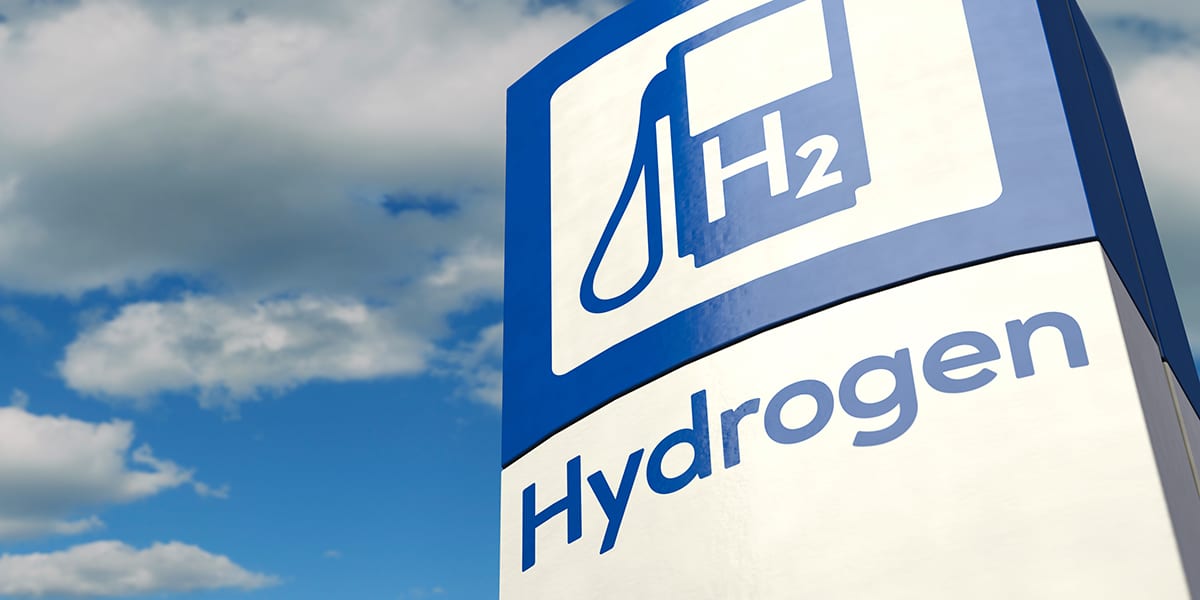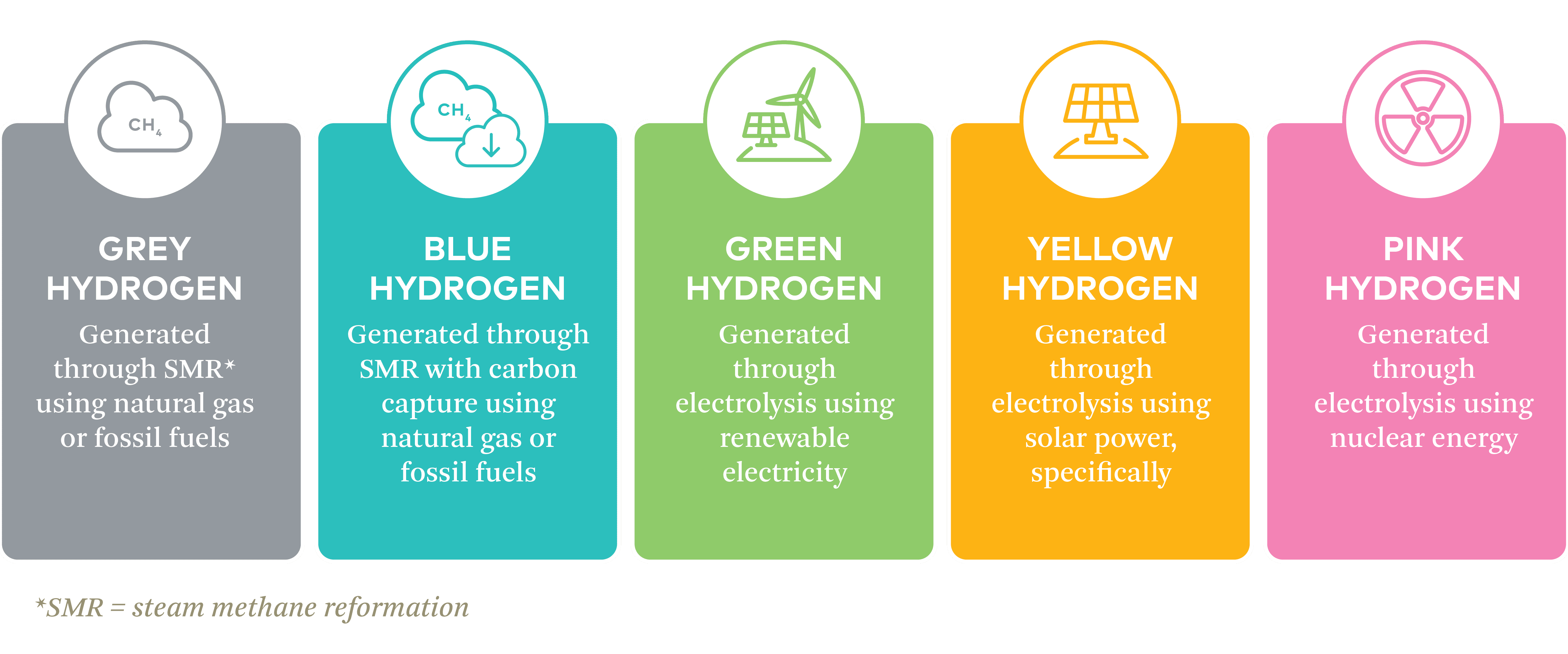Hydrogen has been receiving growing attention in recent years, especially in the transportation sector, for its potential to significantly reduce greenhouse gas (GHG) emissions from trucks, buses, planes, ships and other modes of transit.
Hydrogen is a naturally-occurring, plentiful element that is non-toxic and odorless. However, it does not occur in its elemental form on Earth and therefore must be generated from other hydrogen-containing sources. Roughly 96% of all hydrogen produced worldwide is generated using fossil fuels, with natural gas being the most common feedstock. [1] The cheapest and most standard way to produce hydrogen is through a thermal process called steam methane reforming (SMR).
The hydrogen generated from natural gas using SMR is often referred to as “gray hydrogen.” A newer alternative to this conventional production method is electrolysis, whereby electricity is used to split water into hydrogen and oxygen. When electricity from renewable sources is used in the electrolysis process the product is often called “green hydrogen”.
The vast majority of hydrogen produced today, regardless of its source, is used in the production of petrochemicals and ammonia —~94% of the hydrogen produced in 2018 was consumed by those industries. [2] However, low-carbon hydrogen has the potential to decarbonize a myriad of industries, including steel making [3], energy production [4] and storage, and transportation – both as a direct fuel and in the production of other low-carbon fuels. [5]
Hydrogen on the Color Wheel
Technological advancements and headlines around a product known as “green” or renewable hydrogen have been gaining serious attention in the last couple of years. The “green” color classification is typically assigned to hydrogen produced via electrolysis using low-carbon or renewable electricity inputs, such as wind, solar, or hydro power, inducing no or very low GHG emissions. Some will also apply this designation to hydrogen produced using biomethane as the feedstock, but this designation is less common.
While there is an industry-wide agreement that green hydrogen will be necessary for deep decarbonization, there is not an agreed definition against which it can be verified or validated. Electrolytic hydrogen that is produced with default grid electricity is not “green” because our electric grid contains shares of fossil electricity. The key is ensuring that the electricity used to produce hydrogen is renewable.
In determining total lifecycle emissions associated with hydrogen used in vehicles, the emissions associated with the feedstock – electricity in the case of green hydrogen – must be considered. These lifecycle emissions are often calculated as carbon intensity (CI), or the emissions per unit energy of fuel. Reducing the CI of hydrogen produced via electrolysis requires using lower-carbon sources of electricity.
Hydrogen can be produced through several processes that have historically been represented via a spectrum of hydrogen color classifications, including blue, yellow and pink. Blue hydrogen is essentially gray hydrogen produced via SMR that utilizes carbon capture and storage technology to trap the associated greenhouse gas emissions. Pink, red and purple are common colors referring to hydrogen generated via electrolysis where the power comes from nuclear resources, while yellow is a newer phrase for solar-powered electrolytic hydrogen.
Reframing hydrogen classifications
While in the recent past hydrogen has been classified through this color framework, policymakers are finding it more useful to think about the fuel from a carbon intensity perspective on a lifecycle emissions basis to more fully capture the nuances in how hydrogen can be produced. For example, hydrogen produced from renewable natural gas (RNG) does not neatly fit into any of the above colors, but has significantly lower lifecycle emissions due to avoided methane emissions. In addition, roughly 50-55 kWh of electricity is required to produce 1 kg of hydrogen through electrolysis and the source of the energy used to drive this electrolysis has the potential to impact the CI score. Using a mix of on-site renewables and grid electricity or using electricity from a cleaner grid will result in lower-carbon hydrogen, but these differences are not easily captured in the hydrogen color scheme.
For electrolytic hydrogen, there are also considerations related to whether the electricity is produced onsite or taken from the grid and whether it is used during on-peak or off-peak times that are critical to ensuring the production does not worsen overall electricity emissions or grid resiliency.
To develop hydrogen sustainably, producers can avoid exacerbating grid peaks, procure excess renewable energy that would otherwise be curtailed, and ensure new renewables are placed on the grid. It’s hard to prove that clean energy was physically delivered to the electrolyzer, or that the power used in electrolysis was zero-carbon. Producers of electrolytic hydrogen do not always have access to renewable resources nearby. As a result, showing that hydrogen production is low carbon and aligned with deep decarbonization remains a difficult challenge to overcome.
Hydrogen fuel has the potential to drastically decarbonize the transport sector, but up until this point, cost and infrastructure roll out have been consistent barriers. Effective clean fuel policy-making will likely catalyze the production of hydrogen as a viable fuel alternative. With greater availability comes more consumer uptake, resulting in more competitive market prices. Additionally, incentives that reward FCEV purchases will help spur the number of early adopters. Market-based incentive programs — like the LCFS and Oregon’s Clean Fuels Program — exist with the goal of making alternative fuels like hydrogen more economical and competitive.
In the second part of this two-part blog series coming next month, we will explore hydrogen’s role in helping to create a zero emission transportation sector, as well as the incentives and policies that aim to accelerate the clean transition. Visit our service page to learn about more transportation decarbonization solutions.
Resources:
1. The Future of Hydrogen. International Energy Agency, 2019.
2.The Future of Hydrogen. International Energy Agency, 2019.
3. Can Industry Decarbonize Steelmaking? Chemical & Engineering News, 2021.
4. Hydrogen Energy Storage. Energy Storage Association, 2021.
5. Biodiesel and Other Renewable Diesel Fuels. National Renewable Energy Laboratory, 2006.



